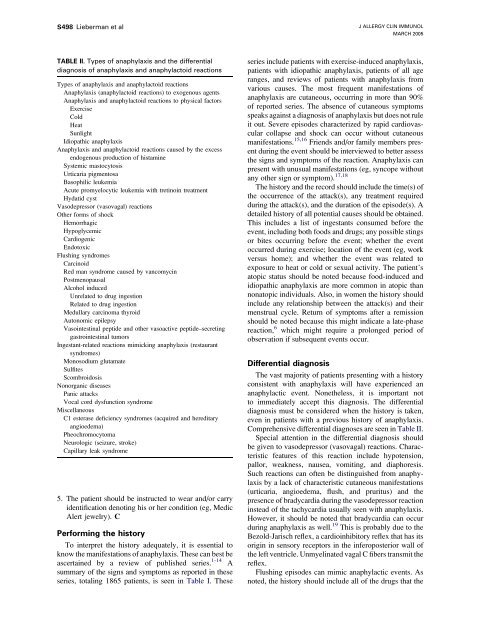Immunotherapy Safety for the Primary Care ... - U.S. Coast Guard
Immunotherapy Safety for the Primary Care ... - U.S. Coast Guard
Immunotherapy Safety for the Primary Care ... - U.S. Coast Guard
You also want an ePaper? Increase the reach of your titles
YUMPU automatically turns print PDFs into web optimized ePapers that Google loves.
S498 Lieberman et al<br />
J ALLERGY CLIN IMMUNOL<br />
MARCH 2005<br />
TABLE II. Types of anaphylaxis and <strong>the</strong> differential<br />
diagnosis of anaphylaxis and anaphylactoid reactions<br />
Types of anaphylaxis and anaphylactoid reactions<br />
Anaphylaxis (anaphylactoid reactions) to exogenous agents<br />
Anaphylaxis and anaphylactoid reactions to physical factors<br />
Exercise<br />
Cold<br />
Heat<br />
Sunlight<br />
Idiopathic anaphylaxis<br />
Anaphylaxis and anaphylactoid reactions caused by <strong>the</strong> excess<br />
endogenous production of histamine<br />
Systemic mastocytosis<br />
Urticaria pigmentosa<br />
Basophilic leukemia<br />
Acute promyelocytic leukemia with tretinoin treatment<br />
Hydatid cyst<br />
Vasodepressor (vasovagal) reactions<br />
O<strong>the</strong>r <strong>for</strong>ms of shock<br />
Hemorrhagic<br />
Hypoglycemic<br />
Cardiogenic<br />
Endotoxic<br />
Flushing syndromes<br />
Carcinoid<br />
Red man syndrome caused by vancomycin<br />
Postmenopausal<br />
Alcohol induced<br />
Unrelated to drug ingestion<br />
Related to drug ingestion<br />
Medullary carcinoma thyroid<br />
Autonomic epilepsy<br />
Vasointestinal peptide and o<strong>the</strong>r vasoactive peptide–secreting<br />
gastrointestinal tumors<br />
Ingestant-related reactions mimicking anaphylaxis (restaurant<br />
syndromes)<br />
Monosodium glutamate<br />
Sulfites<br />
Scombroidosis<br />
Nonorganic diseases<br />
Panic attacks<br />
Vocal cord dysfunction syndrome<br />
Miscellaneous<br />
C1 esterase deficiency syndromes (acquired and hereditary<br />
angioedema)<br />
Pheochromocytoma<br />
Neurologic (seizure, stroke)<br />
Capillary leak syndrome<br />
5. The patient should be instructed to wear and/or carry<br />
identification denoting his or her condition (eg, Medic<br />
Alert jewelry). C<br />
Per<strong>for</strong>ming <strong>the</strong> history<br />
To interpret <strong>the</strong> history adequately, it is essential to<br />
know <strong>the</strong> manifestations of anaphylaxis. These can best be<br />
ascertained by a review of published series. 1-14 A<br />
summary of <strong>the</strong> signs and symptoms as reported in <strong>the</strong>se<br />
series, totaling 1865 patients, is seen in Table I. These<br />
series include patients with exercise-induced anaphylaxis,<br />
patients with idiopathic anaphylaxis, patients of all age<br />
ranges, and reviews of patients with anaphylaxis from<br />
various causes. The most frequent manifestations of<br />
anaphylaxis are cutaneous, occurring in more than 90%<br />
of reported series. The absence of cutaneous symptoms<br />
speaks against a diagnosis of anaphylaxis but does not rule<br />
it out. Severe episodes characterized by rapid cardiovascular<br />
collapse and shock can occur without cutaneous<br />
manifestations. 15,16 Friends and/or family members present<br />
during <strong>the</strong> event should be interviewed to better assess<br />
<strong>the</strong> signs and symptoms of <strong>the</strong> reaction. Anaphylaxis can<br />
present with unusual manifestations (eg, syncope without<br />
any o<strong>the</strong>r sign or symptom). 17,18<br />
The history and <strong>the</strong> record should include <strong>the</strong> time(s) of<br />
<strong>the</strong> occurrence of <strong>the</strong> attack(s), any treatment required<br />
during <strong>the</strong> attack(s), and <strong>the</strong> duration of <strong>the</strong> episode(s). A<br />
detailed history of all potential causes should be obtained.<br />
This includes a list of ingestants consumed be<strong>for</strong>e <strong>the</strong><br />
event, including both foods and drugs; any possible stings<br />
or bites occurring be<strong>for</strong>e <strong>the</strong> event; whe<strong>the</strong>r <strong>the</strong> event<br />
occurred during exercise; location of <strong>the</strong> event (eg, work<br />
versus home); and whe<strong>the</strong>r <strong>the</strong> event was related to<br />
exposure to heat or cold or sexual activity. The patient’s<br />
atopic status should be noted because food-induced and<br />
idiopathic anaphylaxis are more common in atopic than<br />
nonatopic individuals. Also, in women <strong>the</strong> history should<br />
include any relationship between <strong>the</strong> attack(s) and <strong>the</strong>ir<br />
menstrual cycle. Return of symptoms after a remission<br />
should be noted because this might indicate a late-phase<br />
reaction, 6 which might require a prolonged period of<br />
observation if subsequent events occur.<br />
Differential diagnosis<br />
The vast majority of patients presenting with a history<br />
consistent with anaphylaxis will have experienced an<br />
anaphylactic event. None<strong>the</strong>less, it is important not<br />
to immediately accept this diagnosis. The differential<br />
diagnosis must be considered when <strong>the</strong> history is taken,<br />
even in patients with a previous history of anaphylaxis.<br />
Comprehensive differential diagnoses are seen in Table II.<br />
Special attention in <strong>the</strong> differential diagnosis should<br />
be given to vasodepressor (vasovagal) reactions. Characteristic<br />
features of this reaction include hypotension,<br />
pallor, weakness, nausea, vomiting, and diaphoresis.<br />
Such reactions can often be distinguished from anaphylaxis<br />
by a lack of characteristic cutaneous manifestations<br />
(urticaria, angioedema, flush, and pruritus) and <strong>the</strong><br />
presence of bradycardia during <strong>the</strong> vasodepressor reaction<br />
instead of <strong>the</strong> tachycardia usually seen with anaphylaxis.<br />
However, it should be noted that bradycardia can occur<br />
during anaphylaxis as well. 19 This is probably due to <strong>the</strong><br />
Bezold-Jarisch reflex, a cardioinhibitory reflex that has its<br />
origin in sensory receptors in <strong>the</strong> inferoposterior wall of<br />
<strong>the</strong> left ventricle. Unmyelinated vagal C fibers transmit <strong>the</strong><br />
reflex.<br />
Flushing episodes can mimic anaphylactic events. As<br />
noted, <strong>the</strong> history should include all of <strong>the</strong> drugs that <strong>the</strong>
















